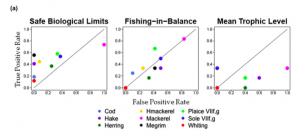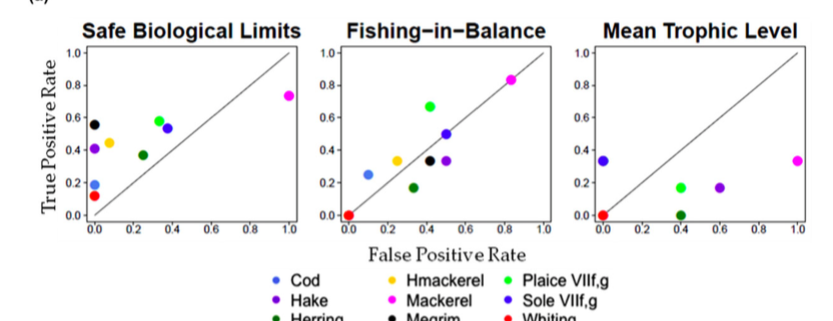Integration of Indicator Alarm Signals for Ecosystem-Based Fishery Management
By Robert Roemer, SRC Intern
Taking into account different stakeholder’s priorities, while combining ecological, economic, and recreational indicators for managing sustainable fisheries have been a long-standing problem. While not a new issue, these quandaries are only compounded when opinions conflict within each ecological, socioeconomic, and recreational stakeholder class.
A recent study conducted by Duggan et al. 2015 aim to address this problem by utilizing a ‘signal detection” approach, by focusing on shifting issues of multiple indicators usually with inconsistent, conflicting units to a simpler state. In the researchers eyes, simplicity is vital to successfully managing fisheries stocks. By reducing conflicting management approaches and units to just two management options (reduce harvest rate or not reducing the harvest rate), researchers can calculate just one signal, termed the “Response Support Signal” (RSS). The Response Support Signal is derived from the complete range of indicators and opinions then quantifies the level of support to reduce, or not-reduce the harvest rate.
How did the researchers determine the RSS?
First, time series fisheries data was obtained from ICES reports for a total of nine Celtic Sea stocks. Then, 21 indicators were obtained from the literature that covered a variety of metrics like: average weight; discard rate; species evenness; and fuel costs over different time frames. From each indicator, a “status signal” was computed, with each status signal composed of two stages; (1) the indicator or “warning signal” which revealed if each indicator was beyond its threshold, and (2) if adjusting the indicator via a hypothetical change would align with the warning signal (i.e. reducing when indicator is beyond threshold and not reducing when within its threshold). From this, sets of indicator-stock combinations are formed with each having a respective status signal: Hit − (H −), Hit + (H +), Miss (M), and False Alarm (FA). From the frequency of status signals in each indicator, the true positive rate (TPR) and false positive rate (FPR) were calculated by:
TPR= N(H −) / N(H −) +N(M) and FPR= N(FA) / N(H +) + N(FA)
where N(x) denotes the frequency of occurrence of x. The TPR is then plotted against the FPR to determine the degree of alignment between decisions and the indicator values.

Figure 1: ROC plots where each point represents a fish stock time series. The further to the top left corner, the more often management actions were appropriate to indicator signal. Points below the line and right indicate inappropriate responses to indicator signal.
What has been concluded?
When data is pooled across stock and years, it shows historical management trends to be independent of indicator alarms. A higher occurrence of H + and M rather than H – and FA, indicates a bias of historical management practice to not reduce fishing mortality (64% of years analyzed). However, what is surprising is after investigating all eight stakeholder scenarios, it was found that all support a reduction in fishing mortality from 1980 to present, with special emphasis on the timeframe of 1990-2003.
The authors in this study identified the critical need for fisheries management to be scientifically objective, and have offered a framework that is both practical and effective for assessing a variety of indicators that are integral to the field of fisheries management. The defined RSS values include objective indicator information that harmonizes with stakeholder preferences, a valuable asset to be used for management decisions. One object of note, the authors acknowledge this tool is not necessarily intended to advise mangers to what course of action is best management, but to structure the communication and to facilitate discussion between various stakeholder groups to help achieve best practices.
Reference:
Duggan, D. E., Farnsworth, K. D., Kraak, S., & Reid, D. G. (2015). Integration of Indicator Alarm Signals for Ecosystem‐Based Fishery Management. Conservation Letters, 8(6), 414-423.




Leave a Reply
Want to join the discussion?Feel free to contribute!